How to paint red brick white. Choosing a dye and the process of painting a brick wall
The need to paint brick surfaces arises quite often. This could be the repair of facades, “budget” finishing of walls inside industrial premises, or, for example, upgrading the space on the balcony.
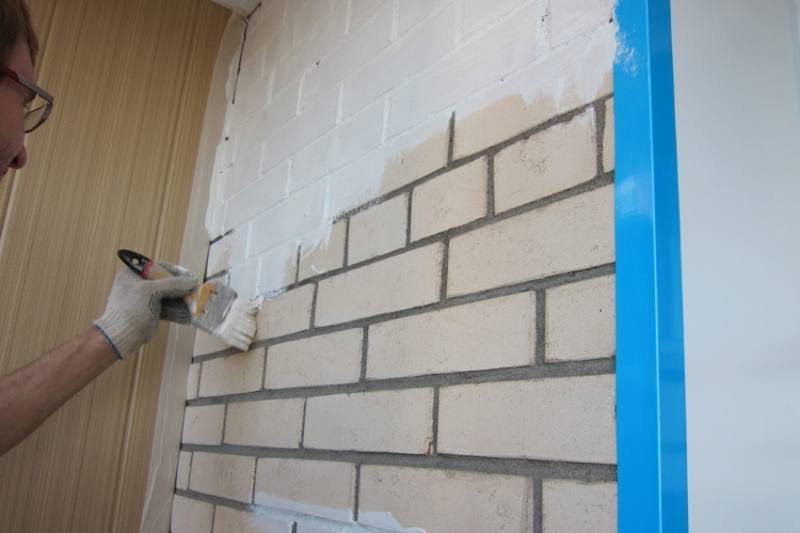
In principle, such work is not difficult to do - you just need to follow certain rules and then everything will turn out beautifully. And if you adhere to the technology published below, then a little paint will be used and it will last a long time.
Therefore, you must agree, it’s definitely worth studying the principle of proper painting.
Let's start with the most important thing.
How to paint
You can often see brick walls painted with whatever was at hand. On the one hand, this is economical - you don’t need to spend money on buying new material, but on the other hand, it is unreliable. Because unsuitable paint will begin to peel off from the plane of the wall within a season and become covered with cracks.
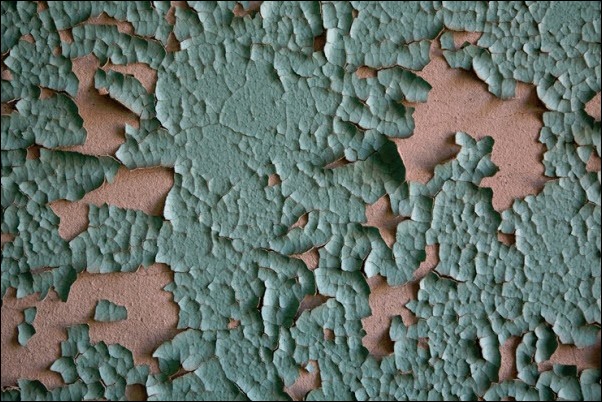
Alkyd paints
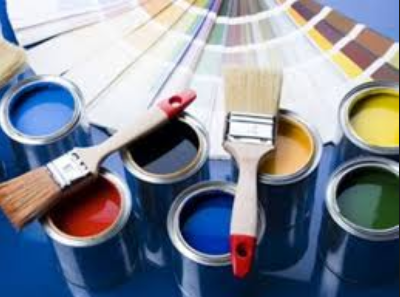
This is an excellent and durable option with a fairly large selection of colors. In fact, these are the usual paints in iron cans. They are made on the basis of alkyd resins (they are obtained by boiling various vegetable oils) and acids.
The good thing about the material is that it holds firmly when it dries and does not emit any toxic or unpleasant odors.
But there is also an unpleasant moment - during painting the “aroma” will be such that just hold on.
The disadvantages include the fact that the price of the paint is not very low. In addition, the consumption per square meter is large.
Tip: to reduce paint consumption, use solvents.
The color is not lost from them, the strength of the layer is also not compromised, but the material will be used more economically.
And besides, if the paint is diluted with the same “White spirit”, for example, then it will be easier and faster to apply.
Next option.
Acrylic and other water-based paints
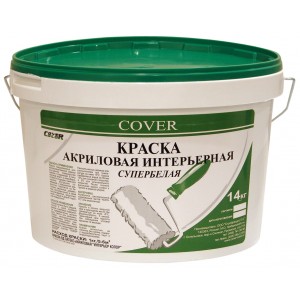
These are paints based on components made from acrylic resin. They are distinguished by the good appearance of the layer in the end, low consumption, variety of colors and prices - you can choose a material to suit any budget.
In addition, acrylic products do not emit strong odors - thanks to this, you can work with them even in a residential area, without fear for the health of others.
The disadvantages include the not very high strength of the final layer, and also the fact that cheap options do not cover minor plane defects, unlike alkyd analogues.
In general, if we talk about what paint to paint a brick wall, then both options are quite suitable for such work.
Now let's look at how to actually paint.
Painting a brick wall step by step
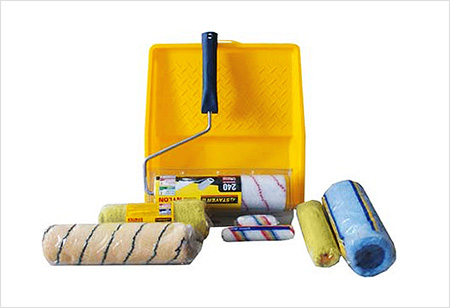
For work we will need the following tools and materials (except for the paint itself):
- bath and roller;
- brushes of various thicknesses;
- masking tape;
- solvent (for alkyd paints);
- wall primer and large brush;
- bucket;
- spatula to remove remaining solution.
As you can see, you need little equipment and there is nothing expensive in it.
Let's start working with our own hands:
- We clean the walls from debris and excess mortar.
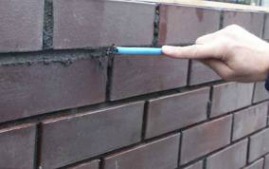
- We glue masking tape around the entire perimeter of the ceiling and floor, where they adjoin the wall. If you don’t do this, you will certainly stain the ceiling or floor - this has been tested in practice.
- Pour the primer into a bucket, take the largest brush and carefully treat the entire wall. This is necessary so that the paint adheres better to the surface and, of course, for less material consumption - due to the presence of a primer, less paint will be absorbed into the wall structure.
- We take a brush and first process all the seams between the bricks. Make sure there are no drips or drips.
- Pour paint into the tray, wet the roller well so that approximately the same, uniform amount of liquid is obtained over its entire area. We paint the wall using movements from bottom to top and vice versa. In this case, it is important to ensure that there are no stripes left from the edges of the roller on the plane of the wall.

Please note that you also need to squeeze it thoroughly after dipping it into the paint.
If you do not do this, then there will be too much liquid on the instrument, which will simply splash in all directions and drip onto the floor.
And if you don’t squeeze it out, you won’t be able to create a uniform, monochromatic layer on the wall.
In principle, this is the end of the painting. Look at the result - if the color does not seem too saturated to you, then you can try applying another layer of paint. There is no need to prime the previous layer.
Well, now a few words about the design.
Painting options
Basic painting methods brick wall there are several. Let's take a look at the most popular methods.
So, how to paint a brick wall - a few simple ideas:
- The entire wall is rolled up with paint of the same color - the advantage of this method is the high speed of the work.

- Painting the bricks one color and the seams between them another. If you do this, it will turn out contrasting and quite beautiful. Only it will take a little more time than in the first case.

- Painting the bricks themselves in different colors. It turns out interesting, but here you spend more time and money - after all, you need to buy paints of different colors.
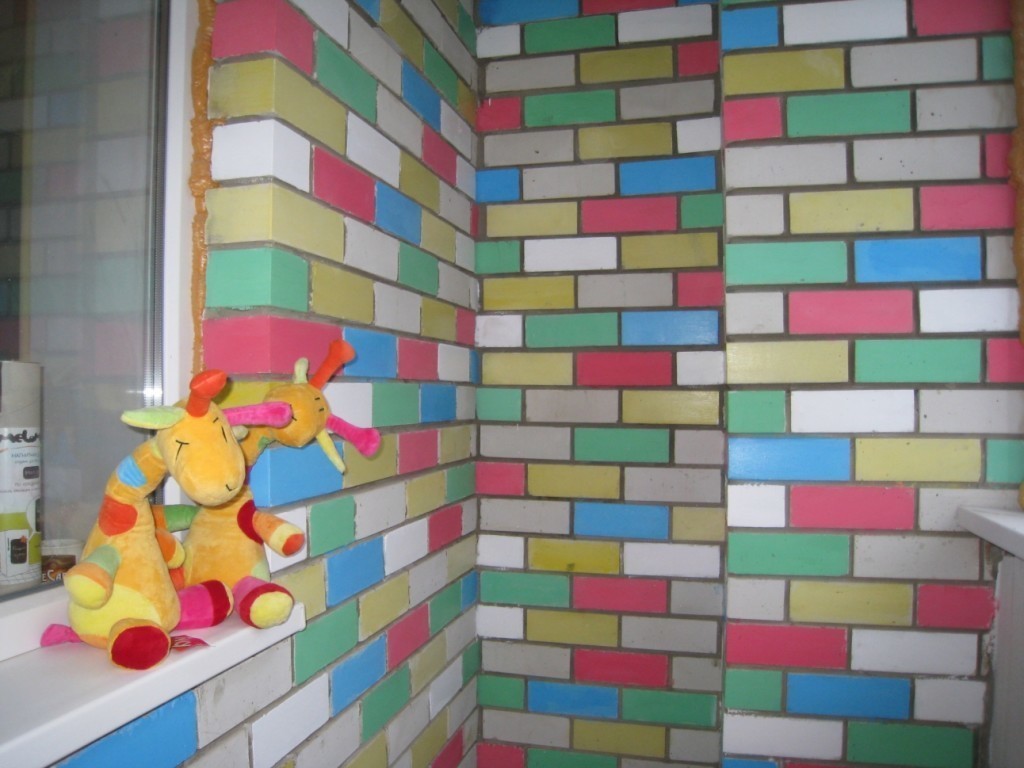
These are the solutions. In principle, a lot depends on your imagination - if you wish, you can make a textured brick surface from a completely smooth plane. To do this, you just need to first paint the entire plane with one color, and then mark the lines with upholstery cord and apply paint to them with a brush.
That's all!
Let's summarize.
Conclusion
We have discussed in detail how brick walls are painted, how it can be done, and what design options there are. We even looked at how to paint a wall to look like brick. We hope that you will be able to apply the acquired knowledge in practice.
Well, if the information provided is not enough for you, then we advise you to also watch the video in this article.
- Required materials and tools
- Choosing the right paint
- In what order should the work be carried out?
- How to repair cracks
- The right primer
- How to apply paint to a brick wall
When the brickwork of a house is smooth and neat, it does not need to be plastered, but simply painted. This is to prevent moisture from getting under the brick and mortar. Excess moisture can cause the wall to collapse over time. And of course, this will not only protect the masonry, but also decorate your interior. Below we will look at how to paint a brick wall yourself.
Painting a brick wall is necessary to prevent moisture from getting under the brick.
Brick walls can be painted not only from the outside, but also from the inside. A good design solution could be to paint those places on the walls where the brickwork is visible. Especially inside a living space. For this, it is best to use special, breathable paint. To paint a brick wall in a bathroom or dining room, use a waterproof paint. Acrylic paint is ideal for a hallway.
Required materials and tools
What might you need for painting? Everything depends primarily on the wall, on its condition, and also on whether it is façade or interior. But let's take things in order. You need to prepare the following tools:
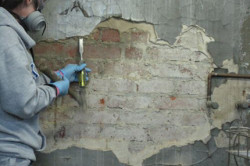
Before painting, the wall must be cleaned of the old coating and sanded.
- wire brush or sponge;
- roller or brush, preferably with stiff bristles;
- sponge;
- spray;
- scraper knife;
- sandpaper;
- safety glasses;
- rubber gloves.
You will need the following materials:
- wall cleaner;
- dye;
- cement;
- grout;
- primer.
To avoid wear of tools on the rough surface of the brick, purchase high-quality and durable tools - rollers, brushes and brushes.
Return to contents
Choosing the right paint
Regardless of which brick wall you are going to paint, external or internal, in any case it is best to use facade paint. Particularly interesting are the following types of paint:

Latex paint for bricks is elastic and bonds cracks well.
- Acrylate.
- Latex.
- Acrylic.
This coloring agent is designed specifically for porous and heterogeneous surfaces.
Brick paint has its own differences from any other types of coloring agents. First of all, it is more elastic and penetrates better under the masonry. Such interesting properties allow it to glue cracks and small gaps between masonry.
Buying at hardware store paint, ask your consultant what kind of walls it is intended for. There's one that's great for painting worn walls, and one that's perfect for covering new masonry. That is, the differences lie in its composition, in the operational period, and, of course, in quality. To work with a small area of the surface, you can use enamel or acrylic. These types are perfect for interior painting work.
Return to contents
In what order should the work be carried out?
Basically, all painting work is carried out in 3 stages, these are;
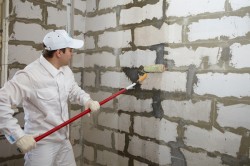
Before painting, the wall must be thoroughly primed.
- The preparatory stage is the preparation of the wall that is planned to be painted.
- Padding.
- Coloring.
You need to start with preparation. This will determine how long the paint will last. Proper preparation should include the removal of all wall defects - small cracks, irregularities, bulges. If the wall is not absolutely flat, then high-quality painting will not work. Keep this in mind when preparing the surface for painting. Using a scraper and sandpaper, remove all visible defects and proceed to sealing cracks.
Return to contents
How to repair cracks
First, use detergent and a stiff wire brush to scrub the entire surface to be prepared. Remove all whitewash residues and traces old paint, if the wall has already been painted before. You can also use a solvent for these purposes, it all depends on how uneven the surface is.
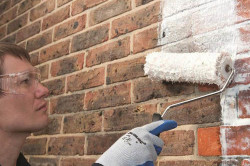
When painting a wall, you need to protect your eyes with special glasses and wear gloves on your hands.
If there is mold or limescale stains on the wall, then the masonry will not last long. Moisture absorbed from outside accumulates in such places. Accordingly, it is necessary to eliminate the presence of mold and plaque. For this, special solutions are usually used. Using a brush, brush all areas where mold and stains are visible with the solution. Finally, rinse the solution with water. When working with the solution, follow safety precautions - wear safety glasses and gloves.
Now carefully examine the entire surface of the treated wall again. There should be no defects on it. If there are small cracks, it's okay, they will be repaired with paint. If there are strong cracks, they need to be cemented. Clean them from dust and dirt, then seal them with cement mortar.
The next step is to level the wall using a washcloth or brush. When the entire preparation process is completed, the wall should be dried. The period of complete drying can take from 10 days to 3 weeks. The main thing is that the surface becomes completely dry, otherwise after applying a layer of new paint, fungi and mold will form after some time. When the wall dries, you can move on to the next stage - primer.
Most ordinary people perceive brick walls as a structural part of a building, intended for subsequent decorative finishing. However, in recent years The position of brickwork in interior design has changed significantly. It increasingly acts as an independent decorative element, with which you can give the room a unique style. To do this you just need to slightly adjust it appearance, for which painting of a brick wall is used.
Treating a brick wall with paints and varnishes allows you to achieve two goals at once:
- Protective function.
- Adding aesthetics.
Protection
Brick has a number of positive qualities, making it the most popular building material. First of all, it is strength and durability - it can be used to build both small private houses and massive multi-story buildings. Due to its high technical qualities, the service life of brickwork can be more than a dozen, or even a hundred years.
However, this is only possible if construction techniques are followed and the necessary measures are taken to protect the masonry from aggressive external influences.

Among the main disadvantages of this material is the fear of dampness. Brick is very hygroscopic: depending on the variety and grade, it can absorb moisture from 4 to 25% of its own “dry” weight. To combat this drawback, the brick wall is painted. The fact is that baked clay is very porous, and water easily fills these tiny holes and cracks, penetrating deep into the brick. Inside, it begins its destructive work, gradually softening the clay and leading to a loss of strength.
In winter, moisture turns into ice and literally tears the brick apart, splitting it into pieces. If you treat a brick wall with a coloring compound, it will fill all micropores and cracks in the surface, thereby blocking the access of water inside the material.
External aesthetics
Recently, placing a brick wall in the interior of both residential and administrative buildings has become a very popular design solution. Thanks to its texture, it will allow you to create a unique and inimitable style in your apartment or office.
Depending on the context of placement, surrounding surroundings or decorative finishing, this can be absolutely any stylistic decision. In some cases, interior designers even resort to painting plastered walls under brickwork.
Using this texture, you can create any style, from ancient classics to ultra-modern high-tech and urban modern.
Paint selection
Before painting a brick wall, you should decide on the choice of paint and varnish composition. It all depends on the area of application of the paint - painting a brick wall in the interior will require a completely different coloring composition than painting the facade, so you should carefully figure out what to paint a brick wall on the street and what to paint in a room.
Facade paints
The external walls of buildings are subject to much greater aggressive influences than the internal ones. In this regard, paint and varnish materials intended for external works, more stringent requirements are imposed than for interior painting. First of all, this:
- Increased resistance to dampness: precipitation, melt water, etc.
- Resistance to solar radiation. A painted wall should not lose its color saturation and brightness under the influence of ultraviolet radiation.
- Resistant to air temperature changes. Paint and varnish compositions must withstand both summer heat and winter frosts well.
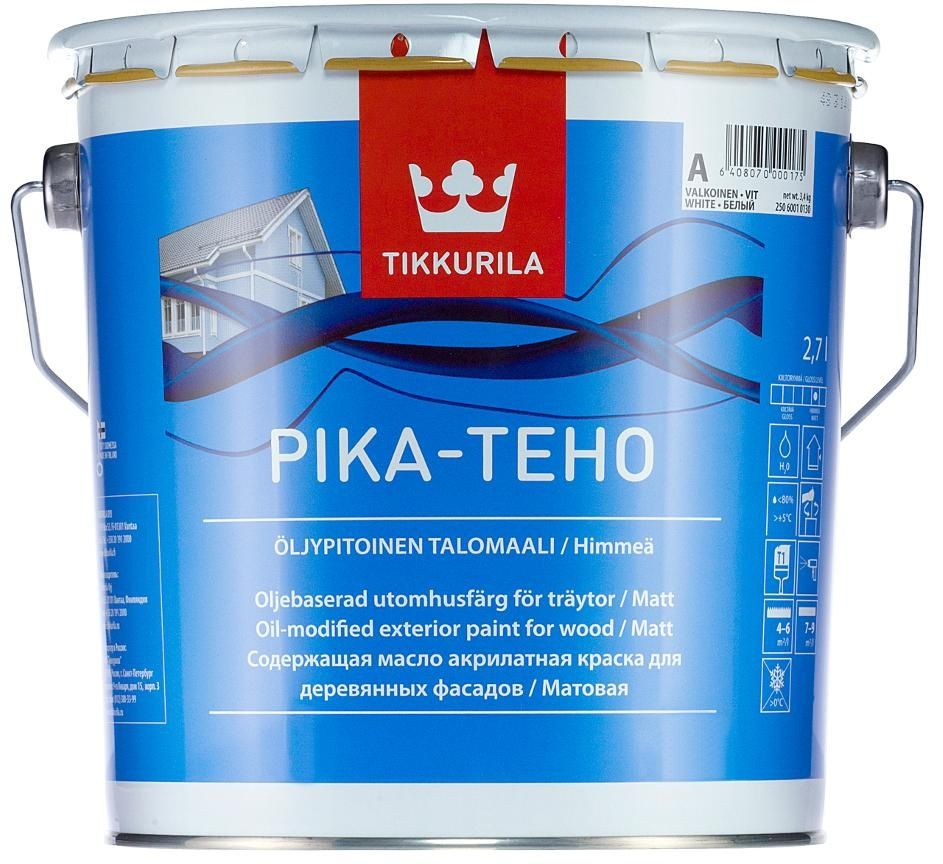
The best options for exterior finishing are water-soluble compounds: latex, acrylic, silicate or acrylate. Among mineral and organic paints we can mention lime, cement, oil and alkyd nitro enamel.
Which of the following compositions is best suited for external walls? Experts advise using latex, acrylic and silicate paints for this. They are highly elastic, which means they will not crack when the supporting base expands/contracts under the influence of cold and heat. Also, these mixtures have good adhesion to the surface being treated and do not fade in the sun, which increases their service life. They lie on the base of the wall in a thin, even layer, reducing the consumption of paint and varnish material.
Oil and alkyd compositions have good technical specifications. However, the thick consistency increases their consumption per sq.m. In terms of performance properties, they are also somewhat inferior to water-soluble compounds: less elastic and more susceptible to ultraviolet radiation.

On the surface they create a dense vapor-proof film. As a result, if the walls are painted with these mixtures, they stop “breathing”: natural gas exchange inside the premises is disrupted.
Compositions for interior work
Paints used for indoor work are not subject to such stringent requirements as for facade paints. However, before painting, you need to decide on the operating conditions: first of all, what is the air humidity in the room being painted.
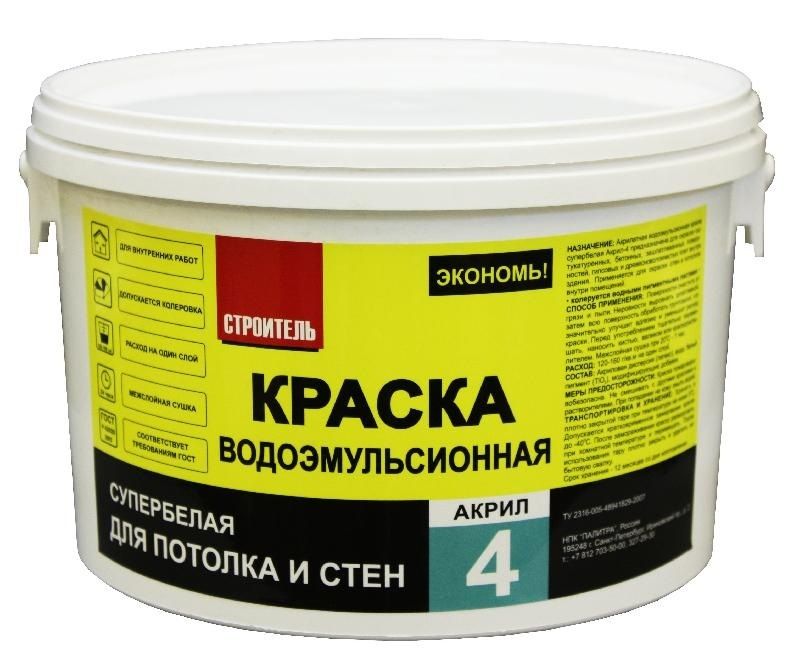
The most popular paint option that is recommended for coating interior brick walls is water emulsion. It is environmentally friendly, durable and affordable. For finishing rooms with high humidity (bathrooms, toilets, saunas and swimming pools), a special, moisture-resistant type of water-based paint should be used.
Another previously very popular method of painting using mixtures based on organic solvents is now becoming a thing of the past. Despite their resistance to moisture, oil and alkyd enamels take a very long time to dry and have a persistent unpleasant odor.
Painting procedure
In order for the paint to last as long as possible, a number of preparatory work should be done before painting the brickwork.
It is not recommended to paint a brick wall immediately after laying. Before painting, you should let it dry thoroughly and allow the natural humidity level to settle. This process can take up to several months. In addition, during this time, the active alkalis contained in the baked clay and masonry mortar are neutralized.
Surface preparation

Preparing a brick wall for painting comes down to cleaning the surface, puttingtying it and priming it. Before pre-treatment, the wall should be given an aesthetic appearance. To do this, using a chisel and hammer, or a grinding machine, the surface is cleaned from various cosmetic defects - build-ups of masonry mortar, uneven masonry, etc.
If necessary, the seams are “unraveled” - deepened and leveled using putty. Also, using putty mortar, you can mask the defects of brick - chips, sinkholes, cracks. After this, the surface is cleaned of construction dust. This can be done with a powerful vacuum cleaner or a damp sponge.
Primer
After cleaning and plastering the wall, it must be thoroughly primed. Some inexperienced amateur finishers neglect this work, considering it an unnecessary waste of time and effort. But, as practice shows, this process allows you to achieve 3 goals at once:
- Strengthening the load-bearing foundation.
- Increased surface adhesion.
- Protection from moisture and fungus.
Surface of any building material has one feature: it is less dense and durable than the inner part, so it is the first to show signs of destruction - cracks, delamination. Primer for brick walls, thanks to the adhesive composition it contains, strengthens the surface and prevents its premature destruction.
Also, primer compositions include chemical additives that have antiseptic properties and protect walls from damage by fungus and mold.
Adhesive primers include crushed quartz sand as a filler. By covering the outside of the brick surface, it increases the adhesion between the load-bearing base and the paint and varnish composition.
All these qualities of soil compositions help to increase the service life of painted bricks. Before treating the wall with a primer, it must be cleaned of dust and dirt. The primer is applied using a roller, brush or spray gun. For best effectiveness, it is recommended to apply the primer in 2-3 layers.
Painting
The technology for applying the paint and varnish composition depends on its type. The following tools are usually used for work:
- Paint brush.
- Roller.
- Spray gun.
- Rolling trough.
When working with paints and varnishes, you should use protective equipment: gloves, goggles and a respirator. The chemical components contained in the paint, if they come into contact with the mucous membranes and respiratory organs, can cause severe allergic reactions.
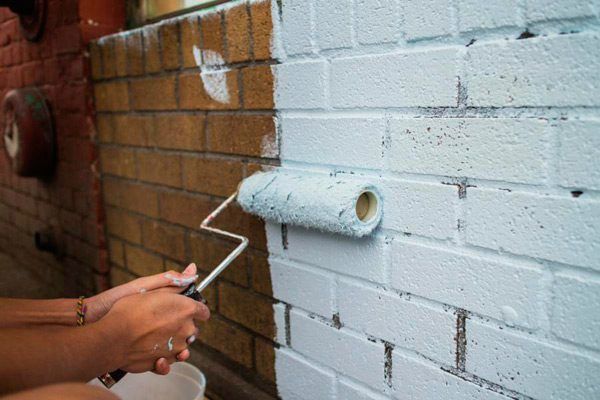
Facade walls should be painted in the warm, dry season. The operating temperature range for most paint and varnish mixtures is from +5 to +25 degrees. At this temperature, they dry evenly, forming a strong adhesion to the surface being treated. Otherwise, the paint may either freeze or dry too quickly. All this will ultimately lead to its rapid detachment from the brickwork.
Often, home owners who decide to carry out renovations on their own have a question: how to beautifully paint a brick wall? For a more uniform coloring, the composition should be applied in at least 2 layers. Each subsequent layer should be applied only after the previous one has completely dried.
The coloring composition applies most evenly when applied with a spray bottle. This method is great for facades and large interior spaces.
If the work is done in small rooms, then it would be best to use a paint brush or roller. IN in this case The paint solution should be applied as follows:
- The first layer is applied in strips directed along the wall. Each strip should be applied overlapping the previous one with an overlap of 2-3 cm.
- After the first layer has dried, a second one is applied, but in a vertical direction.
When working with water-based compositions, you can use a foam rubber or fur roller. When applying oil-based enamels, it is best to use a brush with natural bristles - a roller, especially a foam roller, leaves visible stripes and specks on the wall after rolling.
To distribute the paint evenly over the surface of the roller, use a rolling trough. Having dipped the roller in the paint, you need to squeeze it out by rolling it several times along the corrugated surface of the trough.
Artificial brick
Sometimes the design of a room involves the inclusion of fragments of “natural brick”, but laying a decorative brick wall is not always possible. In this case, you can make such a wall yourself by painting the plastered and puttied surface. The process of painting brick walls is as follows:
- The wall is prepared for painting: it is cleaned, primed, and puttied.
- The entire surface is painted in a color that imitates brickwork - brown, red, orange, yellow, white.
- The next step will be to depict the brick texture. This is achieved by depicting decorative masonry joints on the painted surface.
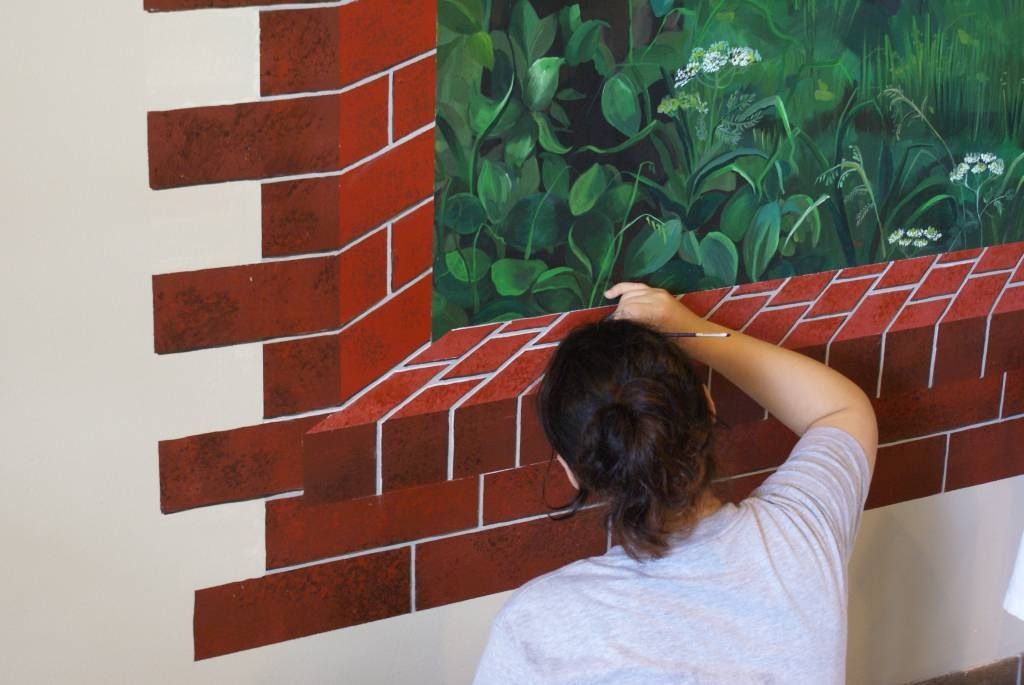
After painting the wall, its vertical marking is made. The pitch of the horizontal stripes should correspond to the height of the brick - that is, 6-8 cm. To enhance the visual effect of the seams, use paint that contrasts with the overall tone of the wall. If you decide to paint a brick wall brown or red, it is better to make the seams white or light gray; for a yellow wall you can use brown joints.
Vertical seams should be staggered for a more natural imitation of masonry.
By following the above recommendations, you can independently decorate the brick surface. By varying color schemes and skillfully using additional accessories and surroundings, you can create an interior in almost any style.
The video below shows how to properly paint brickwork.
Painting internal and external brick walls: features of such finishing, choice of paint and varnish coating and tools, stages of the technological process and rules for caring for painted brickwork.
Benefits of painting brick walls

In the modern market, bricks, thanks to the use of modernized technologies, can be of different colors, shapes, textures and sizes. Despite all the diversity of this building material, there are times when painting brickwork is simply necessary:
- Wall protection. Protection of brick pores and masonry joints from moisture penetration, leading to destruction of the material structure. This process is resorted to by people living in areas with a sharply continental climate.
- Adding aesthetics. Brick decoration is a trend in modern stylistic fashion. With the help of painting, you can transform a wall that previously did not fit into the overall ambiance of the room.
Choosing paint for a brick wall
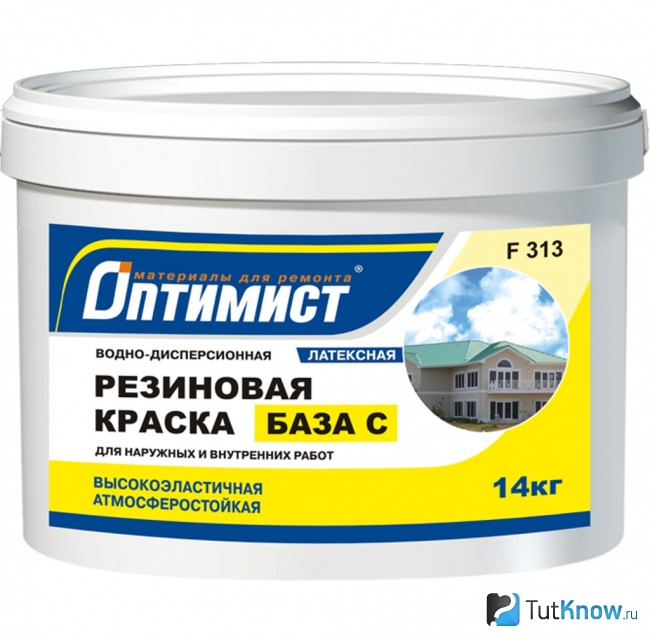
Do right choice When buying paint to decorate a brick wall it is quite simple. The main thing to remember is these conditions:
- The location of the brick wall is external or internal;
- Individual requirements for the performance properties of paint;
- The quality of the masonry.
- Resistant to ultraviolet rays;
- Moisture resistance - especially when it comes to facade paint;
- Resistant to alkali and other chemicals contained in cement mixtures;
- High adhesion rates;
- Air permeability;
- Durability.
Depending on the type of texture, the paint can be matte, semi-matte and glossy. Each of them has a different reflectivity coefficient. In the glossy composition it is as high as possible, while in the matte composition it is absent.
To paint a brick wall on a loggia or on the street, it is recommended to choose facade paint. It is better to give preference to a composition intended for finishing masonry.
If you live in an area with a subcontinental climate, then it is better to use elastomeric compounds for painting external brick walls. They have increased frost resistance and the ability to seal masonry joints.
Also suitable for exterior work are acrylic and latex paints, which consist of synthetic resins that form a waterproof shell on the painted wall. Such compositions perfectly protect brickwork from the effects of negative environmental factors. When choosing a material for painting external brick walls, it is worth taking into account such an indicator as vapor permeability.
Since for painting brick walls indoors it is not necessary to use compounds that have frost resistance and increased moisture resistance, with the exception of the bathroom and toilet, you can give preference to silicate and acrylic paints.
The use of oil paints for brickwork is not recommended. Forming an airtight layer, the composition will soon lead to the destruction of the wall structure. As a substitute for oil paints, you can use a transparent varnish, which will give the brick a natural look and emphasize its texture and color palette.
Selection of tools and materials for painting a brick wall
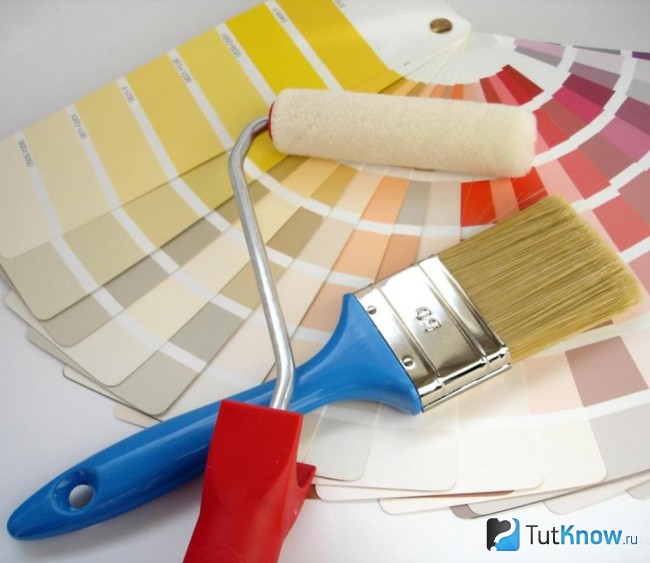
In addition to the paint and varnish material, you need to stock up on special equipment and materials that will be needed to prepare a brick wall for painting and apply the composition to the surface.
The main additional material is primer. Depending on the location, age of the wall and the type of paint used, the primer should be selected from the following varieties:
- Acrylic. Liquid with high penetrating ability. It is an excellent base for latex paint. It is recommended to choose medium or deep diffusion models.
- Silicate. One-component composition for treating brick facade walls. It has good vapor permeability and resistance to precipitation.
- Epoxy. A primer that provides wall surfaces with excellent adhesion and waterproofing.
Since brick is a material with a rather rough surface, it is recommended to use good quality tools with high strength and hard texture.
Preparing a brick wall for painting

If you are determined to paint a brick wall with your own hands, then special attention should be paid to preparing the base. This process is more complex and time-consuming than the dyeing technology itself.
Surface preparation is carried out several days before painting. During this time, the materials will dry completely. To achieve a positive result, it is necessary to comply with the following requirements for organizing and preparing a brick wall for painting:
- Any paint on the wall will interfere with the uniform application of the fresh coating. Therefore, we remove the old finish with a solvent and a paint scraper, which does not damage the integrity of the brick. We use ordinary sandpaper as the sanding material.
- We fill cracks, chips and other flaws with putty. After it has completely dried, we seal it with plaster.
- If necessary, we update the joints of the brickwork using cement mortar.
- We clean the finished surface from paint residues and dust using a stiff brush and detergent.
- Remove grease stains formed on the surface of the base with soapy water.
- To prevent white streaks from being visible on a painted wall, it is necessary to wash the surface with a brush and clean water.
- The washed wall must be completely dry, otherwise defects cannot be avoided.
- We treat a clean brick wall with sealant or special varnish. This procedure will preserve the natural color and texture of the building material.
- We pay special attention to the primer. It not only provides excellent adhesion to the masonry, but also provides moisture resistance and prolongs its service life. A wall treated with a primer will not be exposed to pathogenic microflora, and the paintwork will not crack.
- Apply the primer in several layers and leave until completely dry.
- The construction period of the walls must be more than 1 year. It is after this time that the masonry will completely go through such stages as shrinkage, percolation and moisture balancing. Percolation is the process of leaching substances contained in bricks and cement mortars. When applying paint to a surface where the hardening reaction and neutralization of active alkalis has not completed, rapid peeling and shedding of the composite may occur.
- The brick surface must be clean and free of signs of pathogenic microflora - mold and fungi. Fungicidal solutions can be used as an antiseptic.
- Brickwork should not have whitish salt stains (efflorescence) on its surface. Efflorescence contains chlorides, phosphates and sulfates, which have negative impact on the paintwork and prevent its reliable adhesion to the base.
Technology of applying paint to a brick wall

We paint brick walls in warm and dry conditions. The minimum temperature required for finishing work is +25°C. If the climate regime is not observed, unevenness in the application of layers cannot be avoided.
Before we start painting the brick walls inside, we remove the furniture and other furnishings. If this is not possible, then we move them to the middle of the room and cover them tightly with oilcloth. Don’t forget to also cover the floor covering, which will not be easy to clean if paint gets on it.
We paint the wall using this technology:
- Apply paint to interior walls using a roller or paint brush. We paint in stripes with an overlap of several millimeters.
- We paint the brick walls in 2 layers. It is better to dilute the composition for the first with water (if the paint is water-dispersed), the second is applied only after the previous one has dried.
- Cover the wall in the area of the baseboard, window block or doorway with masking tape. It will prevent paint from getting onto unpainted surfaces. After finishing the finishing work, the tape is carefully removed.
To keep brick walls clean, it is recommended to wash them from time to time using a soap solution. If the integrity of the paintwork is damaged, areas can be easily restored without the need to apply the composition to the entire surface.
How to paint a brick wall - watch the video:
Painting a brick wall is not a very labor-intensive process. The most difficult thing is the choice of coloring composition and high-quality preparation of the base. The above recommendations and photos of painting a brick wall on our website will help you.
A brick wall, under the influence of moisture and temperature changes, gradually collapses, especially the facade. It can be protected by covering it with siding or plastering. Painting a brick wall will provide reliable and beautiful protection. The work does not require special training or sophisticated equipment. You can do it yourself in several stages:
- cleaning the wall;
- sealing cracks;
- primer;
- painting.
Work can only be carried out in the warm season and in sunny weather, especially outdoors. The brick must be dry and the masonry must shrink. You should not paint the wall earlier than a year after completion of construction.
First you need to clean the wall of dust, dirt, old paint and plaster residues. You can use a wire brush. Particular attention should be paid to places where efflorescence has appeared - a white coating in the form of salt or frost. This is a signal about the accumulation of dew on the surface of the brick from the temperature difference between the outside and inside or the penetration of moisture and crystallization of lime. Such stains are carefully cleaned and treated with special acid compounds.
Next is wet cleaning, which finally removes abrasives and chemical residues. Regular sponges and cleaning products will do. Wash the brick and joints with warm water and let dry thoroughly.

Check for cracks, chips, voids. All defects are repaired cement mortar or acrylic and silicon based putty. Small cracks can be covered with latex paint, which is intended for brick walls. Remove protruding seams.
A special primer is selected and applied in a thick layer. This is necessary for its deep penetration into the wall material. Additionally, this impregnation prevents the appearance of fungus and saves paint. Brick walls can be painted without a primer. Then the material consumption will be much greater and you can soon observe the formation of small bubbles. The coating will quickly begin to deteriorate.
In the bathhouse and on the street, brickwork can be coated with a primer twice a day. different directions, creating reliable protection for moisture-sensitive material. After complete drying, final treatment of the walls is possible.
How and how to paint a brick wall
The method of applying the coating to the wall depends on the condition of the masonry and the desired effect. Paint can be applied:
- brush;
- roller;
- spray bottle;
- tampon.
Decorative walls on the street and inside the house are often made using two painting methods. Carrying out work to create the main background and decorate with another technique.
Facade works
Processing of brick walls and fences is carried out in order to give decorative look and protection from destruction. Brick is hygroscopic. It has a porous structure. In winter, water freezes and destroys artificial stone from the inside. In summer, the sun dries out the material, making it brittle, disrupting the connection between the elements. It is necessary to carry out work to protect against corrosion and at the same time you can give the masonry a unique look.
Transparent coating for decorative masonry
Decorative masonry should not be covered with paint and the beauty created by the mason should not be hidden under it. Protective work in the form of a clear varnish coating is sufficient. For outdoor work you can use:
- aqualak;
- clinker oil;
- acrylic varnish;
- parquet wax and varnish.
The brickwork will become brighter, individual elements will appear more clearly, and will be protected from destruction by external factors. Surface preparation is the same as for painting.
Color painting of external walls
Large areas of external walls can be painted using a pneumatic or electric spray gun. Taking into account the roughness of the surface, the angle of the jet should be changed. After the applied paint has dried, you can carry out a number of decoration works.

Convex seams are painted with a thin brush with a contrasting color, emphasizing the masonry pattern. For recessed joints, you can use a hard roller to create the effect of a light coating when protruding areas of the material are painted over. In this case, the paint for the layers is taken of the same color, but in different shades. The stone takes on the appearance of an old, weathered one.
You can create bovar masonry using a brush. After carrying out the main work, paint individual bricks with black paint, lightly brushing the lint over the surface. You can create a specific pattern according to a pattern or do it chaotically. Also treat half as many stones with a light gray or sand tone.
Special materials are available in stores for painting facades. Elastomeric paint can also be used for exterior work. It lays down in a thick layer and perfectly protects brick and concrete joints, penetrates deep into cracks, closing them. Its disadvantage is that it is difficult to apply and high cost.
Decorative painting of interior walls
In the interior, areas with brutalist masonry are increasingly being created. To do this, it is enough to prepare the wall, clearing it of everything foreign, wash it and dry it well. After this, a transparent matte material is applied - varnishes and oil. The number of layers can be 2 - 3, but the coating should be renewed as necessary.

In the bathhouse, bathroom, laundry room, kitchen and other wet rooms, immediately cover the wall in 4 layers. After each application of varnish, you should wait and let the previous one dry completely. It is better to use a brush and very carefully paint over all the irregularities, applying the coating in perpendicular strokes, first vertically, then horizontally.
Plain painting
For kitchens and bathrooms, the wall covering with a protective layer should be especially thick and reliable. Moisture should not penetrate into porous bricks. To do this, the wall is often coated with a thin layer of putty, then primed and painted. The textured glossy surface gives the interior airiness and looks stylish in rooms with a themed design.
Decorating masonry in the interior

An easy way to make your living room look mysterious is to paint a wall like Bovard. The procedure is the same as when the facade work was carried out. Only the background can be done with a brush, carefully rubbing the paint in different directions. After drying, create shades.
You can age the stone using a sponge or gauze pad. Apply a light coating of a different color to the dried background paint, creating looseness and transparency. This method can also be used when working with a stencil, applying silver and golden highlights on a glossy surface.
There are many methods for creating a decorative colored brick wall using paint. Choose the one that suits you and create a unique image of your home.
 Increased tasks required airborne personnel to increase the level of combat training
Increased tasks required airborne personnel to increase the level of combat training Flag of the Airborne Forces "56 DShB" History of the 56 DShB in Chechnya
Flag of the Airborne Forces "56 DShB" History of the 56 DShB in Chechnya Faces of the Afghan War - dedicated to Eduard Anuchin
Faces of the Afghan War - dedicated to Eduard Anuchin